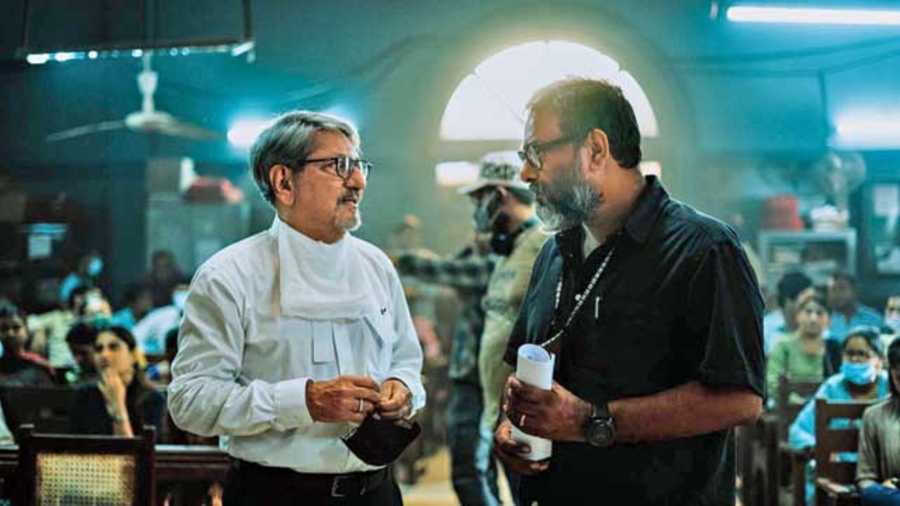Sarthak Dasgupta, director of 200 Halla Ho that’s streaming on Zee5, talks to The Telegraph about his film based on a gruesome real-life incident that has brought back Amol Palekar on screen after almost a decade alongside Rinku Rajguru, Barun Sobti and Indraneil Sengupta, currently streaming on Zee5.
Tell us a bit about yourself.
I am born and brought up in Mumbai. I am an electronics engineer, worked in the software industry, did my MBA from Symbiosis, Pune, majoring in finance.... The Film and Television Institute of India campus was close to ours. I made a lot of friends there from Bengal, including Pritam, the music director. I am self-taught in films. I started out with writing. My first film was The Great Indian Butterfly. My next, The Music Teacher, went to the Sundance Script Lab. The film took 17 years to get made and is now on Netflix. It took me so long to get a break as I had never assisted and I do not belong. But I am glad I am making my third film, 200 Halla Ho.
The title is quite curious.
The figure 200 is there as close to 200 masked Dalit women got into the courtroom to lynch a serial rapist. The incident took place in Nagpur in 2004. This was among the first mob-lynching incidents in India. It is all the more remarkable as it was by the most repressed segment of society, standing up for their self-respect. The story came to me as a writing assignment. A lot of material is available on the incident but there is a lot missing as well. There are many versions too. The police force felt humiliated as the incident took place on their watch. They picked up and charged five random women and tortured them. The film is more about the aftermath of the incident — what happened to the five women.
What were the challenges of dealing with a real incident?
It was technically challenging to tell such a story, fitting it into the structure of a film. Some identities had to be masked as they are still alive. By the time I finished writing they asked if I wanted to direct. The film is on what they did and is a debate on whether they were right or wrong.
When did you shoot?
This March, when Covid was at its peak. Many fell ill during shooting. People’s family members died. One of our lead cast, Saloni Batra, my associate director, associate cameraman, all got Covid. We had to keep shuffling the schedule when an actor fell ill. Tests took place daily and we would wait with bated breath for the results. It was a crowded set. We actually got 200 women. Actors cannot wear masks and even I had to take mine off as it is difficult to speak through. Then the government imposed night curfew and we had to wind up by 7pm. Thankfully, since I was the writer I could keep turning things around.
The court scene must have been crucial.
Yes, the lynching took place in court.
So you did not use technology to cheat the crowd scenes?
No. There was no VFX. It was exactly as you see. It was not a high-budget film. My actors were very nice. They worked as a team. We could not do workshops because of Covid. But everyone understood their role.
How was it working with a senior actor like Amol Palekar?
My first experience of watching a shoot involved him. I was a child then. We were in a taxi when we came across shooting on Marine Drive. The song from Gharonda was being shot, Ek akela is shahar mein. Everyone was craning their neck. When we later watched the film, Ma pointed out that we had seen the shooting. I told him that story. He is very methodical. He said he’d have a lot of questions but he wanted the answers at the start. We did not need to communicate once he was on the set. After a shot, we just caught each other’s eye. That was enough.
Which role did he play?
The National Commission for Women had formed a fact-finding committee headed by a judge. Amol Palekar plays that retired judge. Varun Sobti is the lawyer who fought the case pro bono. Indraneil Sengupta is the police officer. Rinku Rajguru, of Sairaat fame, plays a Dalit girl who had done a hotel management degree and led a better life than the victims. Such a character was there in real life who had come home during the incident and helped the five women seek justice.
What are your thoughts on releasing the film on OTT instead of in theatres?
The medium does not matter. In fact, an OTT release frees you in a lot of ways. To make a film for the theatre, you need a star, a big budget. To recover that cost, you need to tell a story that would appeal to a wider viewer base. So there is a bit of dumbing down. You are tied to the commerce, which may compromise your vision for the film.
